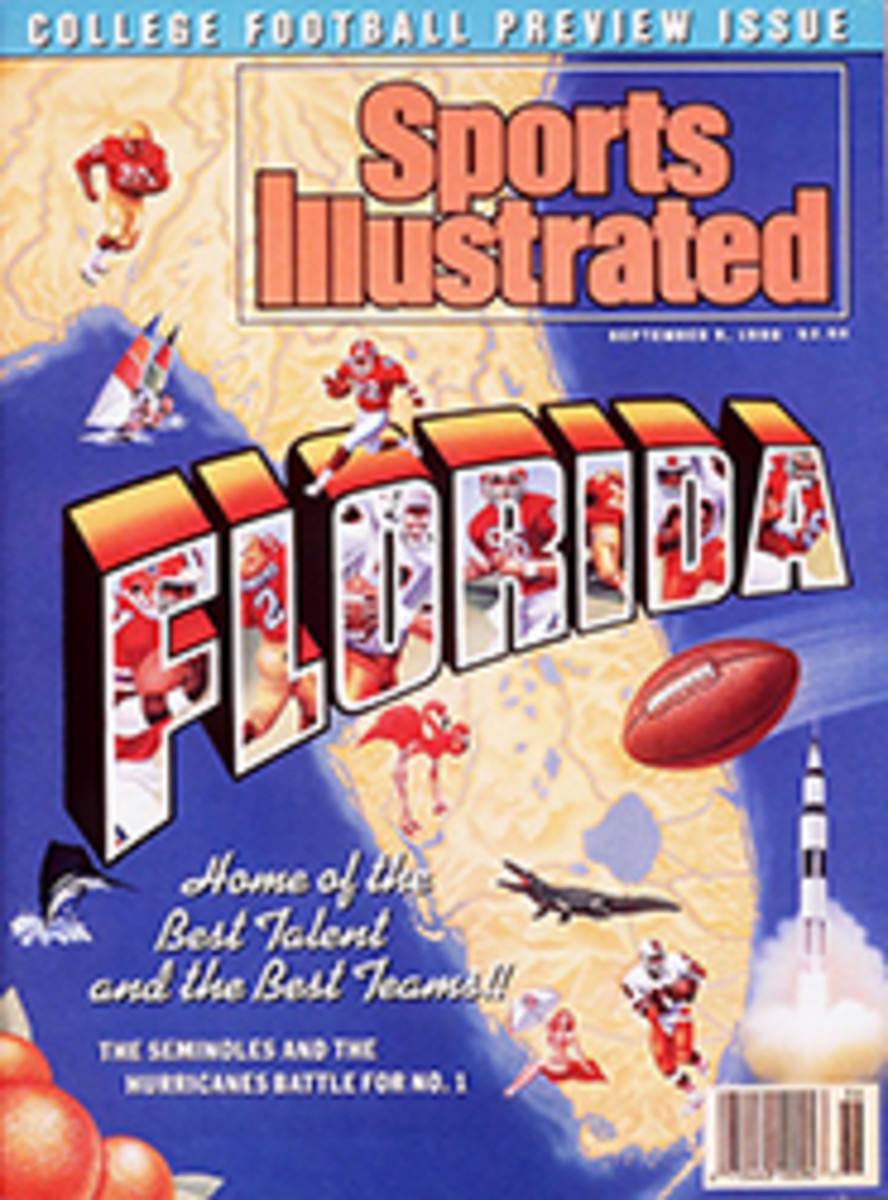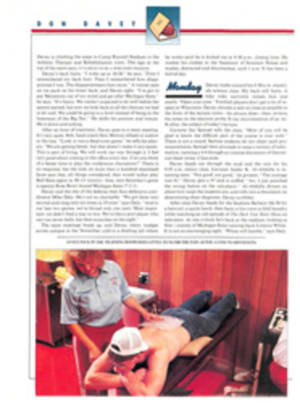
AROUND THE WORLD ALONE
A fantastic voyage ended 90 years ago this summer: On July 3, 1898, Captain Joshua Slocum sailed up the Acushnet River and landed in Fairhaven, Mass., the first to make a successful single-handed circumnavigation.
Many others have sailed around the world since Slocum's time, alone or with a two- or three-man crew. Girding the globe has become almost commonplace, thanks largely to modern self-steering and satellite navigation. Sir Francis Chichester. Alec Rose. Robin Knox-Johnston. Bernard Moitessier, who named his boat Joshua in honor of Slocum. And even Tania Aebi, who was just 21 when she returned to New York Harbor last November.
But Slocum was the first, and his account of that epic three-year voyage, reissued in 1988 (Sailing Alone Around The World, David & Charles), is a classic of sailing literature. For his gift of graceful expression, his quiet humor and his deep, knowing love of the sea, Captain Slocum stands alone. At 5'9½" and 146 pounds, he was described by a reporter as "spry as a kitten and nimble as a monkey." He was 51 years old when he set out.
"As the wind on the morning of April 24, 1895, was fair, at noon I weighed anchor, set sail, and filled away from Boston," wrote Slocum. "Nearby a great steamship, fully manned, officered, and piloted, lay stranded and broken.... So in the first hour of my lone voyage I had proof that the Spray could at least do better than this full-handed steamship, for I was already farther on my voyage than she."
Slocum was born in Nova Scotia in 1844, and he first went to sea in one of Her Majesty's ships at 16. He was appointed an officer at 18, and seven years later, while living in San Francisco, he was given his own command: an American ship. Slocum had by this time become a U.S. citizen.
That first command took him to Australia, where he met Virginia Walker, the daughter of a New Yorker who was prospecting for gold in New South Wales. Virginia was 21 when Slocum sailed his new ship into Sydney harbor. Not long after Slocum's arrival she stepped aboard his ship as his bride.
They moved on to larger and larger vessels until Slocum, though not yet 40, had worked and traded his way to partial ownership of the 1,800-ton Northern Light.
For 14 years, the Slocums made their home at sea. Their seven children, four of whom survived, were born at sea. Then, during a voyage to South America in 1884, Virginia died.
The Captain took his children back to Massachusetts, where two years later the 46-year-old widower married Henrietta Elliot, a cousin. Hetty was 24 and, although from Nova Scotia, she was no sailor. Her only voyage with her husband, which began in 1886, is described in his first book, The Voyage of the Liberdade. That trip to Brazil was marred by a mutiny, two killings, smallpox, cholera, and a shipwreck. Hetty had to help build a new boat and sail it back to the U.S. She never went to sea again.
But Slocum was committed to sailing, though he'd lost his ship and most of his money in Brazil, and though sailing captains now outnumbered sailing ships. He worked at odd jobs on the Boston waterfront until, in 1892, a friend offered him a vessel "wanting some repair."
When Slocum first saw the Spray she'd been sitting in a field in Fairhaven for seven years. However, after "$553.62 for materials and 13 months of my own labor," he launched the rebuilt craft, and "she sat on the water like a swan."
Other observers disagreed, describing the sloop—measuring 37 feet overall, 14 at the beam, and weighing 13 gross tons—as being heavy to handle and difficult to sail. But Slocum paid no attention to the Spray's detractors. He had found a new partner. Together, they would make sailing history.
After leaving Boston in April 1895, Slocum and the Spray sailed to his Nova Scotia birthplace, where he stayed for almost two months. Then, on July 2, Slocum "let go my last hold on America."
He had planned to sail around the world eastward: Gibraltar, the Mediterranean, down the Suez Canal to the Indian Ocean, around the tip of the Indian subcontinent and into the Pacific. But in August 1895, when British naval officers at Gibraltar warned him about pirates operating in the Mediterranean, Slocum decided to head south and west back across the Atlantic to South America.
Arriving there in October 1895, Slocum found old friends from previous journeys, including "an Austrian of broad experience" who offered him a bag of carpet tacks. As it turned out, the tacks proved to be "worth more than all the fighting men and dogs of Tierra del Fuego."
That strange rocky land at the tip of South America lived up to its fierce reputation. On Feb. 11, 1896, the Spray entered the Strait of Magellan. On March 3 his sloop finally reached the western egress of the strait and sailed into the Pacific, straight into a gale that sent the boat flying backward.
Through mountainous seas, the Spray was blown around the southern coast of Tierra del Fuego. Slocum had little choice but to continue to sail in the easterly direction the wind had forced him to go, and he went completely around Tierra del Fuego. This meant he would have to traverse the entire Strait of Magellan again, only this time he would approach the eastern entrance from the south. And this time he met a gang of curious natives who chased after the Spray in canoes and tried to climb aboard the tiny sloop to "talk." Slocum used his rifle to keep the would-be boarders at bay during the day. But by night he needed some rest for the harrowing sailing he knew lay ahead. He remembered the carpet tacks. After dark, before going to sleep, Slocum spread some tacks on deck, making sure that they pointed up. "It is well known," he wrote, "that one cannot step on a tack without saying something about it."
Around midnight, the Fuegians climbed aboard. Creeping across the deck barefoot, they found the tacks. "There was a good deal of free language about it," Slocum wrote of the incident. When he finally cleared the strait a second time, the Pacific offered a warmer welcome, and on April 26 he made the Juan Fernàndez Islands, about 400 miles due west of Valparaíso, Chile. From there he sailed 43 days to the Marquesas Islands on a passage so serene that he decided to continue to Samoa, which he reached in 29 days.
Slocum sailed down Australia's east coast, hoping to head west again after clearing the Bass Strait, but bad weather once again turned him back. He stopped at Tasmania, and there, at Georgetown, he stood before an audience and spoke about his travels. Here, as in every port, people seemed to think that Slocum was starving. They fed him as though he'd survived a shipwreck. When the Spray sailed, she was crammed with bread and cheese, fresh fruit and vegetables, and fish and game.
The Spray sailed back up Australia's east coast and west across the north coast into the Arafura Sea. "It was my good fortune to enter the sea on the last quarter of the moon.... In the dark nights I witnessed the phosphorescent light effect in its greatest splendor. The sea, where the sloop disturbed it, seemed all ablaze, so that by its light I could see the smallest articles on deck, and her wake was a path of fire."
In 23 days Slocum made the Cocos (Keeling) Islands in the Indian Ocean. At landfall, as the island's palm trees appeared, Slocum was overwhelmed with relief: "I sat on deck and gave way to my emotions. To folks in a parlor on shore, this may seem weak indeed, but I am telling the story of a voyage alone."
Across the Indian Ocean, past Madagascar in a gale, he called at Port Natal, South Africa, on Nov. 17. He rounded Cape Agulhas, on Africa's southern tip, on Christmas Day, 1897. After three months of sightseeing by train, Slocum sailed into the Atlantic again.
On May 8, 1898, the Spray passed Fernando de Noronha Island, off the horn of Brazil, and "crossed the track, homeward bound, that she had made October 24, 1895 on the voyage out.... I felt a contentment in knowing that the Spray had encircled the globe." He slowly nosed north until, at 7° 13' north latitude, "for the first time in 3 years I see the north star." By June 25 he was off Long Island and headed for Newport.
"On July 3rd, with a fair wind, the Spray waltzed beautifully round the coast and up the Acushnet to Fairhaven where I secured her to the cedar spile driven in the bank to hold her when she was launched. I could bring her no nearer home."
Slocum's journal ran as a serial in The Century Magazine, and in 1900 it was published as a book. Book sales, lectures and exhibitions brought him enough money to buy a farm, but in 1905, Slocum returned to the sea. On a voyage to South America in 1909, he and his boat vanished, never to be seen again.
ILLUSTRATION
TIMOTHY C. RAGLIN
Bernie Lee, who lives in Portland, Ore., is writing a book about radio's golden age.

